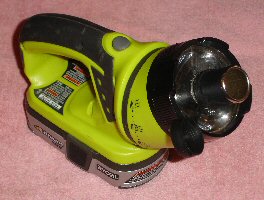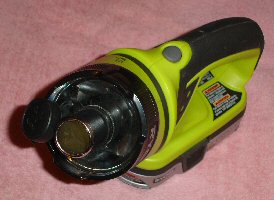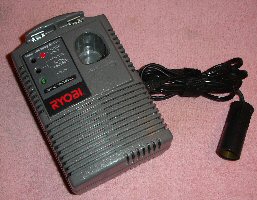Have you ever modified a Ryobi 18v tool to make a new tool?
Of course! I wish Ryobi would sell a device that converted their 18v batteries to a regulated 12v DC power supply. Then I could operate any portable tool that was designed to operate in a car.
My first stab at this worked pretty well. I sacrificed a Ryobi FL1400 flashlight and mounted a cigarette lighter socket in the lens where the bulb would normally be. I cut off part of the battery end so that it would fit a Sears Craftsman 12v battery pack (same stem as the Ryobi 18v) because at the time I owned drills and a recip based on the Sears 12v pack. This worked well and allowed me to plug in and use a variety of low current 12v devices directly from a 12v pack. Portable cellphone chargers may be commonplace now, but there was no such thing back in the late 90s when I built this. When I moved to Ryobi 18v tools in 2004 I put a simple 7812 voltage regulator in the flashlight to get a steady 12v @1A. While nauseatingly efficient, it worked. I have since ripped apart the FL1400 and sacrificed a P703 for the same purpose, but this time I used an MC78T12C (12v, 3A). With the P703 mod I get 3x the current and it's far less top heavy so it doesn't topple over.


But I wanted more.
What I really wanted was a regulated 12v supply at 15A, the same current rating as most car cigarette lighters. I tried several designs, all of which failed to supply the desired 15A for more than a minute before overloading. I eventually stumbled across a device known as the 24v DC to 12v DC step-down converter. This is a mass manufactured device (i.e., cheap) that's used to step down the 24v in some trucks, tractors, lorries, etc., to 12v so that typical 12v devices can be used. I remember that most 12v car batteries are charged up to 13.8v, and most 12v devices are designed to cut off around 10v, so I think a vehicle that contains a nominal 24v supply is likely to see a range of voltage from 20-28 during normal operation. I figured that step-down converters must be designed to operate not just at 24v, but over a range below and above 24v. Most manufacturers of these devices do not specify an operating range for the input voltage. Those that do specify a low input voltage of 18v. But that's not good, using a Ryobi 18v battery for input the device would stop operating long before the battery was completely discharged.
Ryobi 18v Lithium Ion packs contain one or two strings of 5 18650 cells, for which the operating voltage is 2.8v-4.2v. Therefore the 18v pack should be at 4.2x5=21v at full charge and 2.8*5=14v when fully discharged. So ideally the 24v to 12v step-down converter's input range should be greater than this range. Luckily I found one vendor selling a device rated for 15A and an input range of 13v-28v (on eBay). It works like a champ! Inside this device are three identical circuit modules connected in parallel, so I assume that each is rated 5A. I gutted an old Ryobi Multivolt charger and fit the guts of this device in it. Sure enough, testing shows that I can draw 12v at 15A from this device when connected to a P104. I haven't tried to draw this much current for more than 5 minutes, but hey, it works!

The next step was to connect a miniature 12v DC to 120v AC power inverter to this thing. Yep, this works, too. I can now operate any 120v device, up to about 150 watts, using just a Ryobi 18v battery for power. I'm short on practical applications, but it sure is a nifty doohickey.

Right now (Dec 2009) I've got it in my truck box, and I use it to power a couple strings of LED Christmas lights that I strung around the bed. My kids love it and it lasts over four hours on one P104 battery without a worry of discharging my truck battery. I use my P131 Dual-Chemistry in-vehicle charger to recharge the tool battery the next day while I'm driving so it's ready for the next night.
Waitaminit! 15 amps at 12 volts? Can a Ryobi 18v battery safely deliver that much current?
Good question! Let's see, 12v at 15A = 180 watts. So at 18v that's a 10A draw. Assuming 90% efficiency of the DC-DC step-down device (it's a guess, one day I may try to quantitate this) we're talking 198 watts or 11 Amps at 18 volts.
A P104 contains cells rated 10C in parallel, for an effective 20C rating which means 24 Amps. No problem.
A P103 contains cells rated 10C, which means 13 Amps. A little close for comfort, but within specs.
I don't know what the discharge rating is on the cells in the NiCd packs (P100 and older), but I'd guess 10C. For a Ryobi P100 battery pack that means 17 Amps and for older packs that's 15 Amps. So we're still within specs.